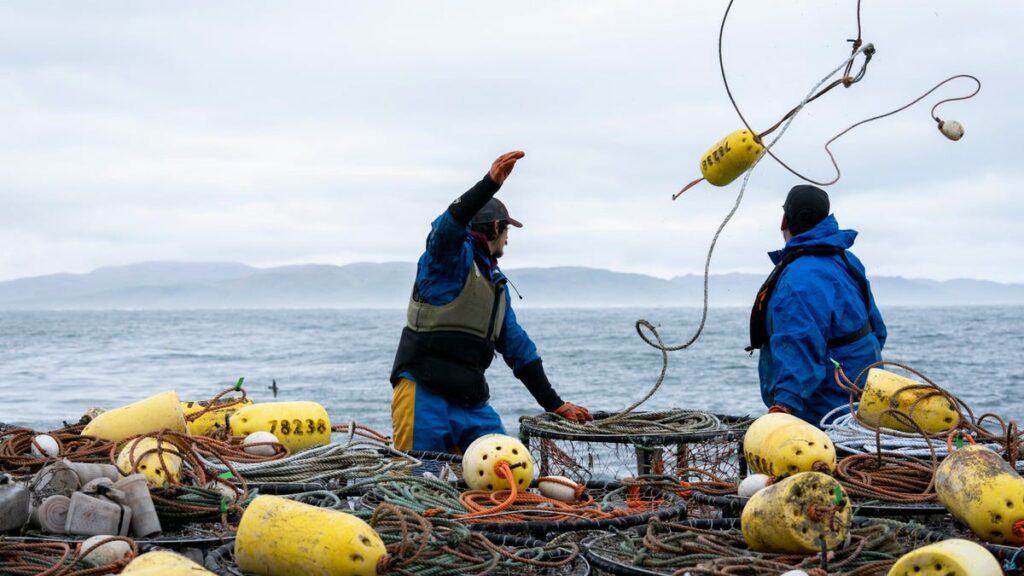Humpback whale severely tangled in fishing lines finally free
Officers from the Fisheries and Oceans Canada Marine Mammal Rescue came across a humpback whale who was severely tangled in fishing lines.
SAN FRANCISCO – California Dungeness crab, a staple of holiday celebrations for many West Coast families, won’t be widely available before early December and possibly not until next year – again.
For the sixth year in a row, the state’s Department of Fish and Wildlife has delayed the start of the commercial crab fishing season through most of the state’s coast to protect endangered humpback whales from getting entangled in vertical fishing lines, which can result in injuries and death.
Dungeness crabs, larger, meatier and more abundant in California than other species, are treasured by locals as well as tourists, who frequently consume them at San Francisco’s Fisherman’s Wharf. The crustaceans are mostly found in the central and northern parts of the state.
Moving the starting date from the usual Nov. 15 to no earlier than Dec. 1 and likely later, deprives their enthusiasts of the homegrown delicacy before Thanksgiving. More pointedly, it impairs a fishing industry already reeling from the cancellation of the past two ocean salmon seasons because of diminished stocks.
“We’re having to minimize our time based on the migratory patterns of these particular animals,’’ said Richard Ogg, who leads an advocacy group on the Sonoma County coast north of San Francisco. “Nobody likes to do that, because it does have a tremendous financial impact on us, but we as fishermen feel it’s important to protect these animals.’’
Giving humpbacks time to migrate south
The delay is meant to provide more time for the whales to migrate south for the winter after building up blubber feeding off the shore.
Surveys this month by the Department of Fish and Wildlife in five of the state’s six fishing zones found 99 humpbacks one day in the zone encompassing San Francisco and 73 another day in the next zone south of the city, which includes Santa Cruz and Monterey. Those numbers are considerably higher than the threshold of 20 in a zone that triggers a delay to the season’s opening.
In addition, the agency recorded 14 whale entanglements with fishing gear from May 17 to Oct. 20 of this year, four of them from commercial crabbers, one more than would prompt the end of the rest of a season. The last two seasons were shut down in April instead of the traditional June.
The limits are part of the department’s Risk Assessment and Mitigation Program, established in 2020 to address a significant increase in injuries from fishing gear reported on humpback whales.
The regulation became necessary when the number of whales near the coast spiked after a marine heat wave from 2014 to 2018 apparently pushed their prey – such as sardines and anchovies – closer to shore, and the humpbacks followed.
Ogg, a member of the state’s Dungeness Crab Task Force, an advisory body that assesses management measures, points out the humpback population has been steadily growing for several years, closing in on 5,000 in the eastern Pacific Ocean.
When will the Dungeness crab season begin?
The whales are still protected, though, so the question is when will they head to their winter homes off the Pacific coast of Mexico and Central America, allowing the crabbing season to begin. The last season did not get going until Jan. 18 of this year, and even then there were catch limits.
“These animals are pretty happy,’’ Ogg said. “There’s a lot of anchovies and feed along the shoreline. So, are they going to leave right away? Probably not.’’
Ryan Bartling, senior scientist for the fish and wildlife department, agrees with that assessment. He gets asked about the topic frequently and has a stock answer.
“I tell people, ‘Only the whales know when they’re leaving,’’’ Bartling said. “The second part of my typical response is, look at the last three or four seasons. We typically see whales stay in the area well into December, which has pushed us toward a later start to the season.’’
After further appraising entanglements and the humpback populations near fishing areas, the fish and wildlife department will provide an update around Nov. 15 about a possible opening date. The delay does not affect Oregon or Washington, where Dungeness crabs are also caught.
Bartling acknowledges the rising number of whales leads to more entanglements, and he says the department tries to protect them while being mindful of the crabbers’ needs.
“The delays are our best attempt at trying to find the right balance,’’ he said. “Get (crabbers) on the water as soon as it’s feasible but also minimizing the overlap with a majority of the humpbacks when they’re here.’’
Source link : http://www.bing.com/news/apiclick.aspx?ref=FexRss&aid=&tid=672fad30d8f34614b9a77b0b60930612&url=https%3A%2F%2Fwww.usatoday.com%2Fstory%2Fnews%2Fnation%2F2024%2F10%2F31%2Fcalifornia-crab-season-delayed%2F75955533007%2F&c=1402025467557607964&mkt=en-us
Author :
Publish date : 2024-10-31 09:36:00
Copyright for syndicated content belongs to the linked Source.
